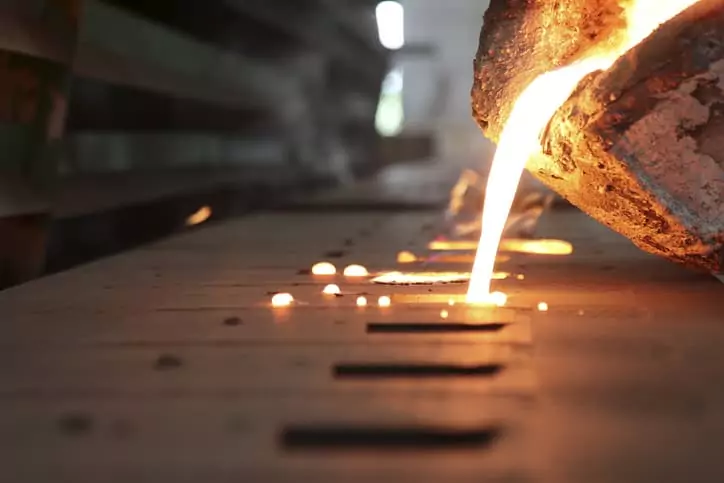Metal casting is a manufacturing process that involves pouring molten metals into a pre-designed mold and allowing them to cool. Several metal casting techniques exist, and choosing the right one can determine the success and quality of the final parts.
Choosing the best metal casting technique is complex, as each has advantages and disadvantages. However, we will divide them into categories using surface finish, dimensional accuracy, and material properties.
Best Metal Casting Method: Quality
The quality of the final cast is the most critical parameter that the best casting service for judging the best metal casting techniques. Among the myriad methods, three stand out based on exceptional quality.
The first is investment casting, which uses wax patterns to form molds, enabling the creation of complex geometries and fine details. It typically yields less porosity, enhancing the metal’s mechanical properties and making it a reliable choice for critical components.
Another metal casting technique is die cast, which is known for making parts with good surface finishes, especially non-ferrous metals like aluminum, zinc, or magnesium. Die casting can occur in high or low pressure inside closed or open chamber systems and can ensure tight tolerances and smooth finishes.
Best Metal Casting Method: Cost
Another determinant of the best metal casting technique is the production cost; here, the methods vary significantly in affordability. The primary factors influencing cost include process complexity, materials, tooling expenses, and production volume.
Sand casting is the best metal casting method for cost, whether for high- or low-volume production. It is cost-effective because it uses inexpensive materials like sand to create the mold, and the materials are reusable with minimal preparation.
Die casting is also a cost-effective metal casting technique for high-volume production. Although it has a high initial investment in tooling, the per-part cost decreases with larger production runs. Die casting is the most economical option for producing thousands or millions of parts with steel die molds.
Best Metal Casting Method: Lead Time
Lead time is crucial in deciding the best metal casting technique, and is important to the best casting service that want to prioritize early market entry. The time is influenced by the speed of mold manufacturing and preparation, the casting process itself, and post-casting operations
Die casting is the fastest method for mass production, with lead times typically shorter than other methods. This is because steel molds are reusable with minimal preparation between casts, and when the molds are in place, the casting process is quick. Nevertheless, the lead times are typically longer for initial setup and mold creation, but the rapid production rate offsets these.
Sand casting is slower than die casting because new molds are needed for each part. However, sand casting offers relatively fast lead times for prototyping and small runs. Sand molds can be quickly created without extensive tooling, making them ideal for short-lead-time projects, especially for large parts.
Best Metal Casting Method: Material Versatility
Consider material versatility when determining the best metal casting technique, especially when the project requires properties like corrosion resistance, hardness, or ductility.
Sand casting stands out for its versatility. It supports ferrous and non-ferrous alloys, making it ideal for producing parts that must endure harsh environmental conditions or high temperatures.
While commonly used for non-ferrous metals like aluminum, investment casting demonstrates versatility by supporting various alloys, including superalloys in high-performance applications. Its ability to handle intricate details with various materials makes it particularly suitable for specialized industries.
Best Metal Casting Method: Environmental Impact
The environmental impact of each casting method is a significant consideration, especially in light of modern sustainability concerns and the goal of reducing waste.
Sand casting is relatively eco-friendly because the sand used in molds can be reclaimed and recycled for future casts. However, the energy consumption of melting metals and managing large-scale casting operations can be substantial.
Investment Casting: While investment casting produces wax patterns and ceramic molds, which generate waste, it’s less environmentally friendly than sand casting. However, precision reduces material usage, minimizing waste in high-quality, low-volume applications.
Best Metal Casting Method: Post-Processing
Post-processing, such as machining, heat treatment, or surface finishing, is often necessary to achieve desired part specifications. The level of post-processing varies among casting methods. The best metal casting technique does not require much post-processing:
Investment Casting: Investment casting typically requires minimal post-processing since parts emerge with smooth surface finishes and high dimensional accuracy. Occasional finishing may be needed, but it’s significantly less than other methods.
Die Casting: Like investment casting, die-cast parts often require minimal post-processing. The high-pressure and smooth steel molds produce parts with tight tolerances and good surface finishes. However, trimming excess material (flash) may be required.
Conclusion
Selecting the best metal casting technique depends on several factors, including surface finish, dimensional accuracy, and material properties. Hence, we divided it into quality, price, lead time, post-processing, environmental impact, etc.
Ultimately, the choice of casting method depends heavily on the project’s specific requirements. However, evaluating your project needs in terms of quality, cost, and lead time can allow you to select the best casting method.

